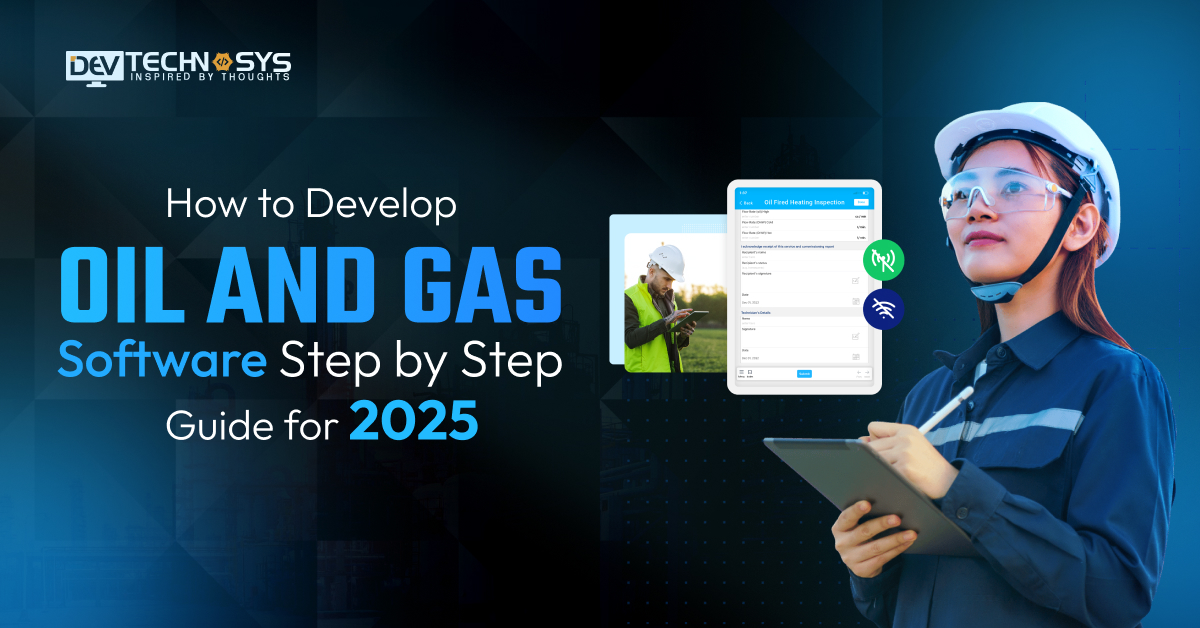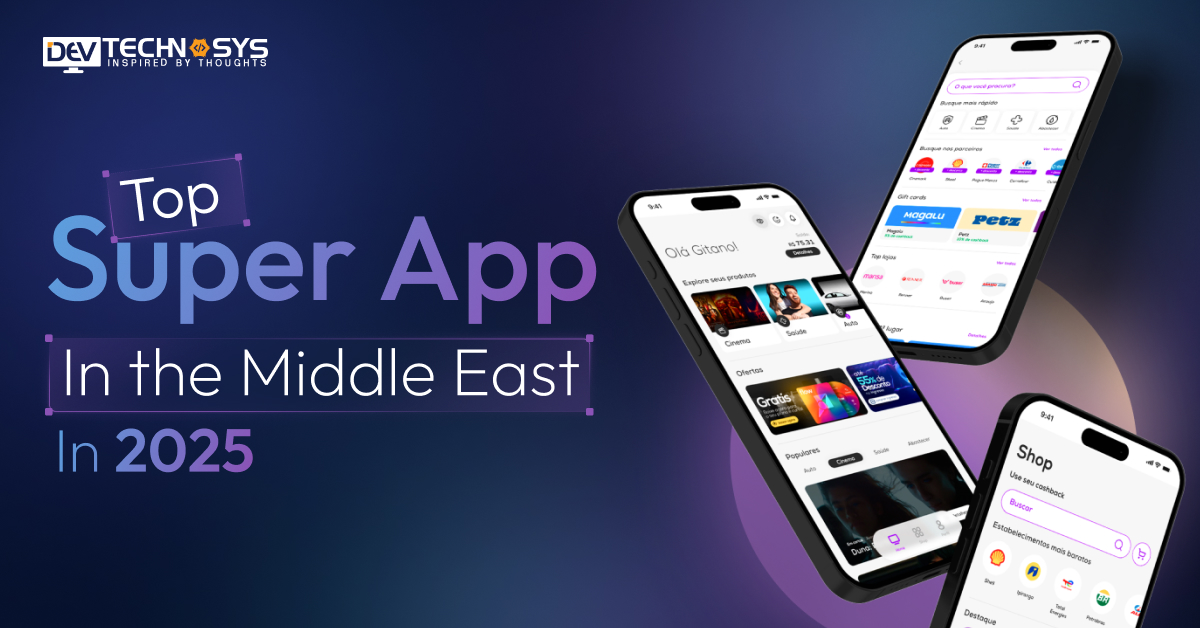Oil and Gas Software: The Engine Behind Smarter, Safer Operations
Next-generation software tools are unlocking hidden reserves for the oil and gas software industry. These software programs provide real-time data monitoring, enable more intelligent decision-making, reduce costs, and offer optimized production benefits.
Oil and gas software are advanced tools and applications designed to boost efficiency, provide real-time insight, and optimize operations. Data analysis and visualization tools are key tools that ensure optimal performance and prevent downtime.
From drilling to identify potential oil and gas reservoirs to refinery floors, oil and gas software trends are reshaping this industry and enabling businesses to experience new heights. In 2025, the global oil and gas market is expected to reach $8184.98 billion.
Does the growth rate of the oil and gas market pique your interest in develop oil and gas software?
Let’s dive into this blog, as it covers all the essential stages, from steps to cost to developing oil and gas software.
What is Oil and Gas Software?
Oil and Gas software are defined as digital platforms and tools that are built to offer support and optimize oil & gas industry operations. In today’s period, the digital landscape is bringing transformative changes in the oil and gas industry.
Oil and gas software companies in this industry conduct in-depth analyses of complex data, automate workflows, enhance asset performance, and improve compliance and safety.To experience the transformations that oil and gas software is bringing to the industry, entrepreneurs must partner with an oil and gas software development company.
This enables them to integrate AI, IoT, GIS, and cloud computing elements into their software, improving its efficiency.
Oil and Gas Market Overview
- In 2023, the global oil and gas market was valued at USD 6,705.68 billion.
- It is projected to expand, reaching an estimated USD 8,917.40 billion by 2031.
- Furthermore, certain segments of the oil and gas market are projected to reach USD 72.6 billion by 2033.
Why Do Businesses Invest in Oil and Gas Software?
The oil and gas software industry is experiencing rapid growth, offering businesses opportunities for increased revenue and expansion. Let’s find out the key reasons that attract businesses to this industry.
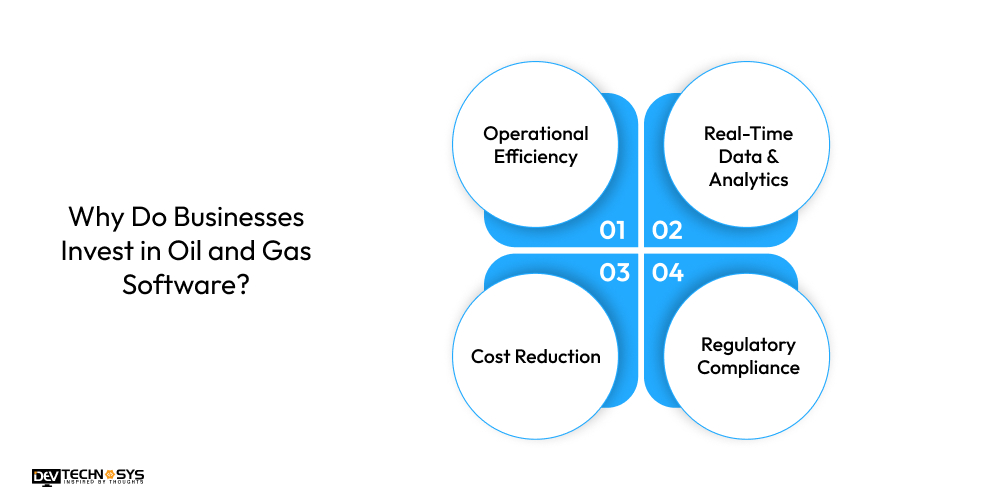
1. Operational Efficiency
To experience growth and earn profit, businesses are investing in oil and gas software at a rapid rate. This software has the potential to automate complex tasks, helping companies reduce errors while optimizing resources.
2. Real-Time Data & Analytics
Businesses are investing in oil and gas software to experience continuous monitoring of operations and equipment. It helps them to have a quick solution to any issues. To develop oil and gas software, businesses are also taking the help of an iOS app development company. This helps them to experience real-time visibility of activities.
3. Cost Reduction
This factor is one of the primary motivations for businesses to invest in oil and gas software. This software has the potential to predict maintenance needs, thereby reducing unnecessary expenses and costs. You need to hire oil and gas software developers to make oil and gas software under budget.
4. Regulatory Compliance
In the oil and gas industry, adhering to compliance requirements is essential. With the help of oil and gas software, businesses are meeting regulatory and compliance requirements. This helps in avoiding legal fines.
How Artificial Intelligence Is Transforming Oil and Gas Software?
Technology has dramatically reformed the oil and gas industry. On a broader scale, businesses in this industry are integrating AI technologies as a powerful tool to enhance decision-making efficiency and reduce costs.
The rise of AI in the oil and gas industry is enabling businesses to leverage AI-powered analytics to predict equipment failures and optimize resource utilization. With AI, entrepreneurs have the opportunity to provide risk analysis and connect predictive modeling.
10 Popular Oil and Gas Software
To tap in the oil and gas software development market, you need to take professional support from the best oil and gas software development company. This helps to develop software in line with industry trends and user needs. Let’s find out the top-rated energy software development firm.
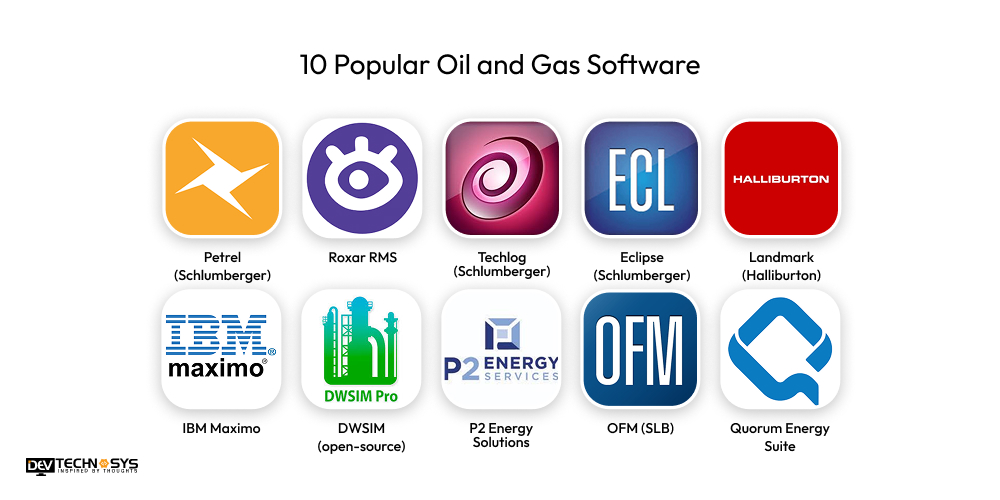
No. |
Software & Vendor |
Launch Year |
Platforms |
Rating⭐ |
| 1 | Petrel (Schlumberger) | 1998 | Windows, Cloud (Delfi) | 4.7 |
| 2 | Roxar RMS | 1987 | Windows, Linux | 4.5 |
| 3 | Techlog (Schlumberger) | 2002 | Windows | 4.3 |
| 4 | Eclipse (Schlumberger) | 1980 | Windows | 4.2 |
| 5 | Landmark (Halliburton) | 1990 | Windows | 4.8 |
| 6 | IBM Maximo | 1990 | Windows, Cloud | 4.6 |
| 7 | DWSIM (open-source) | 2008 | Windows, macOS, Linux, iOS, Android | 4.1 |
| 8 | P2 Energy Solutions | 1990 | Web, On-premise | 4.3 |
| 9 | OFM (SLB) | 2000 | Windows | 3.9 |
| 10 | Quorum Energy Suite | 2001 | Web | 4.0 |
How to Develop an Oil and Gas Software
To create efficient oil and gas software, entrepreneurs need to understand the systematic procedure for step-by-step development. You must connect with a reliable mobile app development company. Having expert guidance and support is helpful.
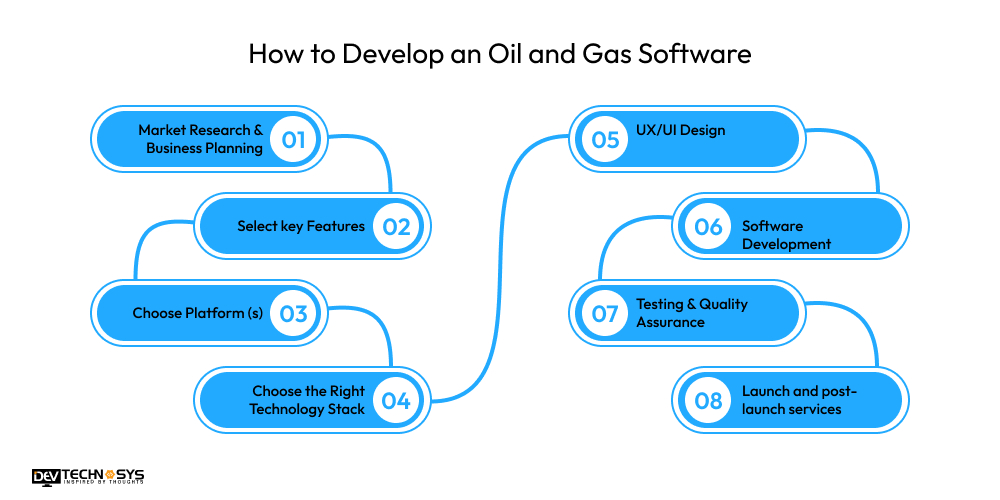
1. Market Research & Business Planning
This crucial stage involves identifying target users and distributors while also ensuring regulatory compliance. Understanding oil and gas industry trends helps create an efficient business plan and develop cost-effective Middle East’s top oil and gas software .
Important Question |
| How important are planning and market research in the software development process? |
| What role do market analysis tools play in supporting decisions? |
| What variables affect the length of market research projects? |
2. Select key features
At this stage, integrating features helps you differentiate your oil and gas software from others. Entrepreneurs can incorporate features like equipment management, real-time monitoring, scheduling, AI, cloud support, and GIS mapping.
Important Question |
| Why does feature selection matter in managing oil and gas software? |
| How does choosing features influence the user experience in oil and gas software management? |
| What impact does selecting the right features have on software success? |
3. Choose Platform (s)
If you want to experience custom software development services, then selecting the right platform is important decision. It helps in reaching the right audience and improves scalability and accessibility. Entrepreneurs can choose from desktop (Windows/Linux), web-based, and mobile platforms (iOS/Android).
Important Question |
| What platforms support the deployment of oil and gas software? |
| What deployment methods are available for oil and gas software? |
| How many platforms support the launch of oil and gas software? |
4. Choose the Right Technology Stack
To build successful oil & gas software, businesses must integrate the right technology stack. With the help of frontend and backend frameworks like Angular, Vue.js, and Spring Boot (Java), you can ensure software flexibility and performance.
Important Question |
| In what ways does the tech stack influence software development? |
| What impact does the tech stack have on development time and expenses? |
| How does the technology stack impact the software development process? |
5. UX/UI Design
Well-designed oil and gas software helps reduce errors and can increase the adoption rate of the software. To compete with top oil and gas software development companies in the market, you need to craft interfaces that consider real-time alerts, as well as mobile and web-friendly layouts.
Important Question |
| How crucial is good UX in oil and gas software? |
| What makes user experience important in oil and gas software? |
| How much time does UX design typically require? |
6. Software Development
To boost the overall software adoption rate, it is essential to ensure that you integrate UX tools like integrative maps, real-time dashboards, and alet systems. To experience efficient oil & gas software development services, businesses must partner with expert technicians and engineers.
Important Question |
| Which tools are primarily used in software development? |
| What key tools are needed to develop oil and gas software? |
| What is the typical duration for software development projects? |
7. Testing & Quality Assurance
Building successful oil and gas software mainly depends on testing and quality assurance practices. It helps in addressing issues such as bugs and safety concerns. To make an app in the mobile apps in oil & gas industry, you need to focus on testing, such as user acceptance testing (UAT) and unit testing.
Important Question |
| How do testing and quality assurance impact oil and gas software reliability? |
| What are the key tools used in testing oil and gas software? |
| How much time is generally needed to complete software development? |
8. Launch and post-launch services
To keep your oil and gas software relevant, it is essential to focus on conducting continuous monitoring, technical support, and user training. Post-launch services help resolve issues quickly and prevent costly interruptions.
Important Question |
| What is the significance of a software launch? |
| Why is post-launch support important for software performance? |
| Why post-launch services are essential following software development |
10 Basic and Advanced Features to Build an Oil and Gas Software
Let’s find out some fantastic features that will help you create unique oil and gas software.
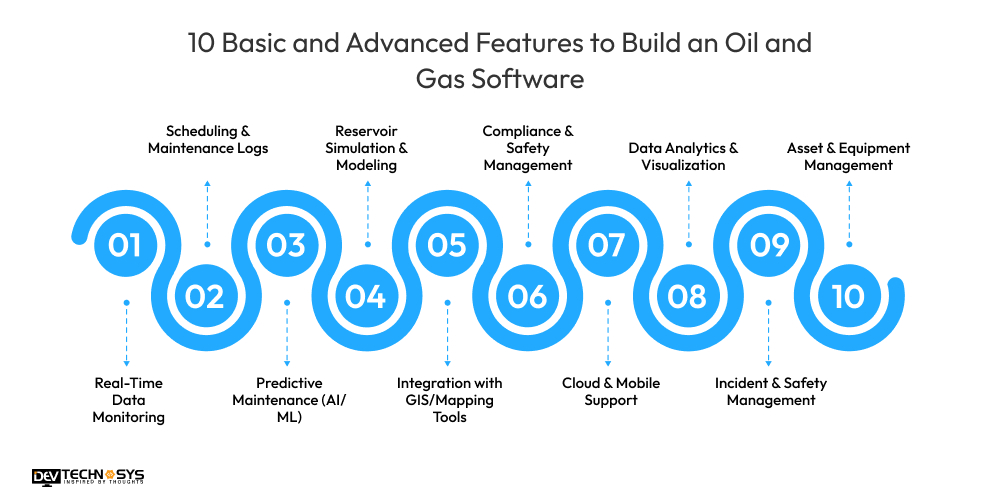
1. Real-Time Data Monitoring
This feature enables the capture of live data from pipelines, field sensors, and equipment. Through this, you can build a oil and gas software while ensuring quick response and timely decision-making.
2. Scheduling & Maintenance Logs
Adding this feature to oil and gas software enables the management of routine inspections, repairs, and preventive maintenance, which helps reduce downtime and extend the life of assets.
3. Predictive Maintenance (AI/ML)
Integration of machine learning and artificial intelligence helps you to create a oil and gas software where equipment failures can be detected before their occurrence. Businesses that require advanced artificial intelligence development services should prioritize having an AI-powered mechanism.
4. Reservoir Simulation & Modeling
Build oil and gas software using 3D geological models, which helps in forecasting production performance and utilizing simulations to optimize extraction.
5. Integration with GIS/Mapping Tools
The integration of GIS and mapping tools offers features such as the visualization of assets, locations, and pipelines. This enables entrepreneurs to engage in advanced risk analysis and planning.
6. Compliance & Safety Management
To make an on-demand fuel delivery app, you need to comply with regulatory standards such as HSE. It offers tracking compliance metrics and automates reporting.
7. Cloud & Mobile Support
Develop oil and gas software that offers features such as seamless data access and mobile support. This helps field engineers and remote workers in this industry to use the app efficiently.
8. Data Analytics & Visualization
The efficiency of your oil and gas software can be enhanced by leveraging features such as big data analytics. This helps track KPIs, identify trends, and inform strategic decisions with the aid of interactive dashboards.
9. Incident & Safety Management
Ensure that your oil and gas software has an in-built feature for recording safety incidents and recommendations for corrective actions, enabling improvements in workplace accountability and safety.
10. Asset & Equipment Management
To minimize downtime and operational costs, effective asset and equipment management is crucial. Integration of this feature to optimize high-value assets’ performance, like rigs, pipelines, turbines, and compressors.
The Cost to Build an Oil and Gas Software
The cost to build oil and gas software ranges from $8,000 to $25,000. This cost varies based on the platforms you choose to launch your software, the technologies to be integrated into the app, and the features. Entrepreneurs need to connect with a reliable oil & gas software development company to identify the accurate cost structure. This helps to create oil and gas software within budget.
App Type |
Estimated Cost |
Development Time |
| Basic MVP Software | $8,000 – $12,000 | 2 – 3 Months |
| Standard Software | $13,000 – $20,000 | 3 – 5 Months |
| Feature-Rich Software | $20,000 – $25,000 | 5 – 6 Months |
| Custom Enterprise-Grade Software | $26,000 – $30,000 | 6 – 8 Months |
Factors Affecting the Cost To Build Oil and Gas Software
Several factors affect the cost to build oil and gas software; these factors have different features that increase the budget. Let’s determine the importance of these factors so that we can integrate them accordingly.
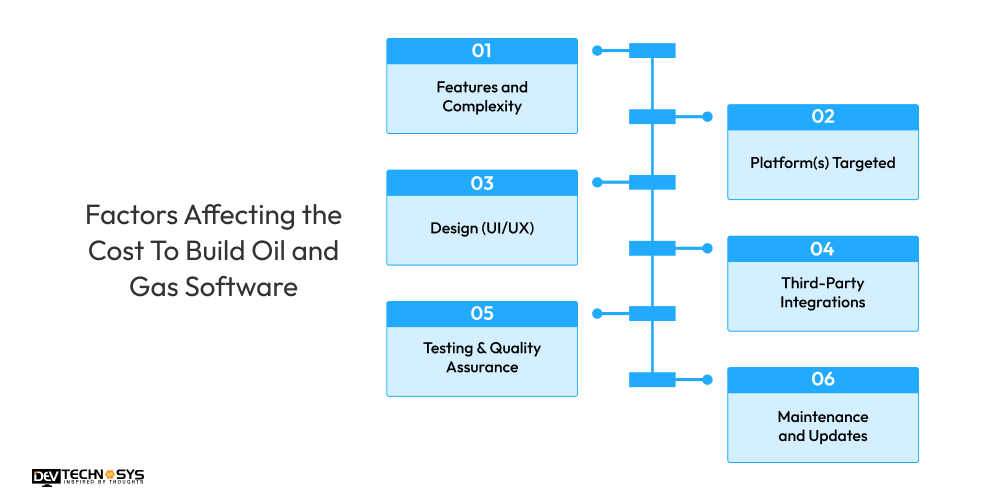
1. Features and Complexity
The cost to develop an app is influenced by the advanced features and tools you integrate into your oil and gas software. Customized features such as GIS, 3D reservoir modeling, and real-time IoT data streaming add to the budget and complexity of the software.
Feature Complexity |
Cost |
Time Scale |
| Basic Listings & Search | $1,500 – $3,000 | 1 – 2.5 Months |
| Intermediate (Chat, Filters, Profile) | $4,000 – $8,000 | 3 – 4 Months |
| Advanced (AI, AR, Blockchain) | $4,000 – $8,000 | 2 – 5 Months |
2. Platform(s) Targeted
To experience efficient oil and gas software development services, businesses need to select the right platforms. This helps them to reach the right audience. However, if you are targeting users across multiple platforms, such as web, desktop, Android, and iOS, then it increases testing and design costs.
Platform Complexity |
Cost |
Time Scale |
| Windows, macOS only, and Linux | $1,500 – $3,500 | 1 – 2 Months |
| All (Native) | $4,500 – $7,500 | 3 – 4 Months |
| Cross-Platform | $4,000 – $6,500 | 2 – 5 Months |
3. Design (UI/UX)
The cost to build oil and gas software is affected by UX/UL complexity, which you want to have. The more personalized layout and design, such as real-time visualizations and interactive dashboards, increase the cost, as compared to basic designs.
UI/UX Complexity |
Cost |
Time Scale |
| Basic UI | $1,400 – $2,000 | 1 – 3.5 Months |
| Custom & Responsive UI/UX | $2,500 – $4,000 | 3 – 5 Months |
| High-End Interactive Design | $3,500 – $5,000 | 2 – 5 Months |
4. Third-Party Integrations
To create a seamless connection between oil and gas software and external systems, such as GIS mapping tools, entrepreneurs experience a smooth data flow and functionality. This affects the cost as it increases technical complexity.
Third-party integration Complexity |
Cost |
Time Scale |
| Basic Backend (CRUD APIs) | $2,300 – $3,300 | 2 – 3 Weeks |
| Scalable Backend + DB | $4,000 – $6,000 | 1 – 1.5 Months |
| Third-party Integrations | $3,500 – $5,000 | 1 – 2 Months |
5. Testing & Quality Assurance
For a successful oil and gas software development process, testing and quality assurance are essential. The more complex the software, the more you need to invest in testing. Features such as IoT device integration, real-time monitoring, and increased security checks, as well as functional testing, are non-negotiable.
Testing Complexity |
Cost |
Time Scale |
| Manual Testing Only | $800 – $1,400 | 3 Weeks |
| Manual + Automated Testing | $1,400 – $3,000 | 3 – 5 Weeks |
| Advanced Testing + Security Audits | $2,000 – $4,000 | 1 Month |
6. Maintenance and Updates
The cost to maintain an app requires regular performance optimization, bug fixes, feature enhancement, and security patches. Entrepreneurs need to handle real-time updates and software handling, which increases the cost of software development.
Updates Complexity |
Cost |
Time Scale |
| Basic (Bug Fixes, Minor Updates) | $1,500 – $2,500 | Ongoing Monthly |
| Standard (Feature Updates, Monitoring) | $2,300 – $4,000 | Ongoing Monthly |
| Premium (24/7 Support) | $5,100 – $8,000 | Ongoing Monthly |
Challenges and Their Solutions In Oil and Gas Software Development
Creating oil and gas software is a complex task, as it requires entrepreneurs to identify unique features, select a suitable platform, and analyze the costs. The following section discusses some challenges, along with solutions that help build software with greater efficiency.
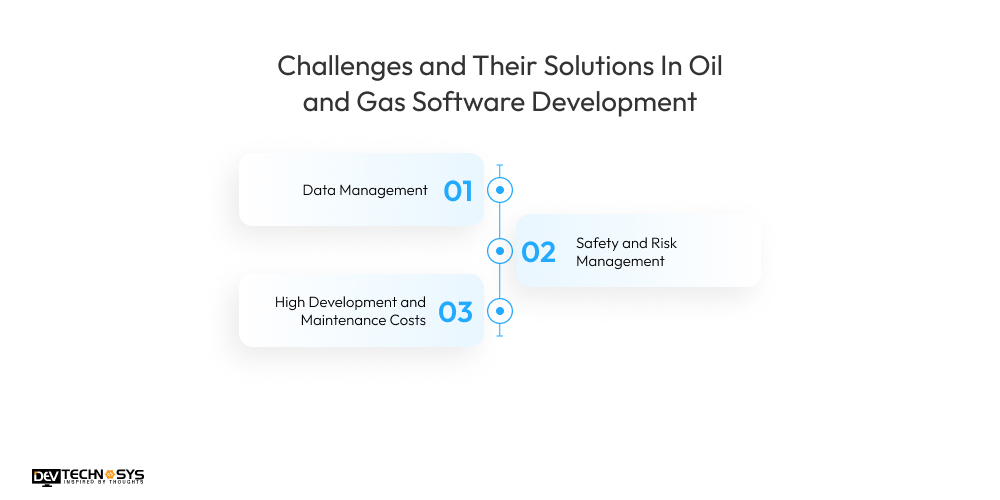
1. Data Management
In oil and gas software management, data originates from multiple sources, creating challenges related to analysis and handling.
To overcome this issue, the integration of solutions like real-time insight helps to have streamlined solutions.
2. Safety and Risk Management
Businesses that experience efficiency in oil & gas software development services in Dubai must comply with changing safety and hazard standards.
To overcome this challenge, entrepreneurs should focus on implementing solutions such as forecast maintenance tools and AI-powered data analytics to mitigate risk.
3. High Development and Maintenance Costs
Creating oil and gas software requires entrepreneurs to make long-term investments in maintenance and updates, which increases the overall cost.
To overcome this challenge, you can use agile development and modular development to reuse components.
How To Make Money From an Oil and Gas Software?
You may be surprised to learn that you can earn money from oil and gas software. Let’s find out some impressive ways to earn extra cash from oil and gas software.
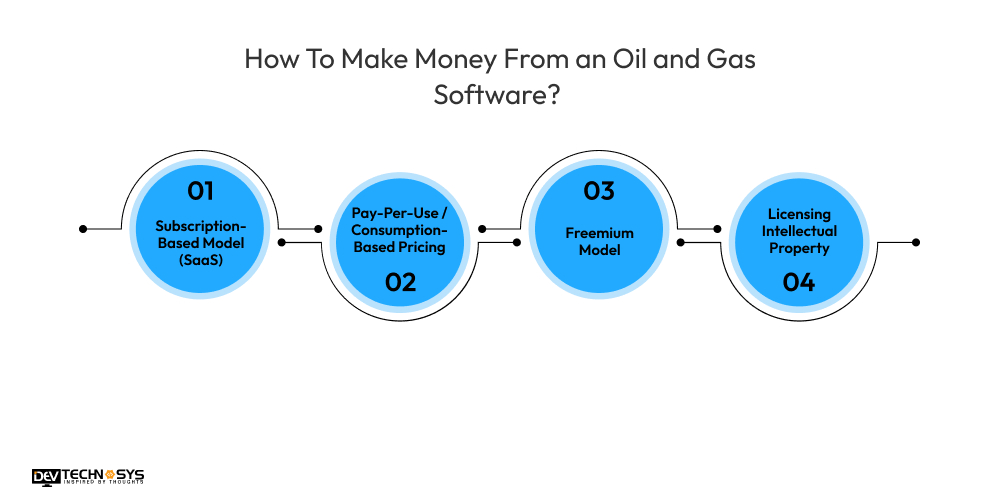
1. Subscription-Based Model (SaaS)
Businesses in the oil and gas software industry can earn additional revenue by offering users access to software on a monthly or annual subscription basis.
2. Pay-Per-Use / Consumption-Based Pricing
This monetization strategy is beneficial for generating continuous revenue. In this case, you can charge consumers based on their actual usage, such as the number of API calls and data processed.
3. Freemium Model
Businesses based on software versions can provide free services to users and can charge fees for advanced and feature-rich models. This model is beneficial in converting potential users to loyal users.
4. Licensing Intellectual Property
Nearly all oil and software development integrates simulation tools and data models. Businesses can monetize this through licensing agreements and earn additional income.
Conclusion
As per the above analysis, we have now come to understand that building oil and gas software is a complex yet straightforward process. By conducting in-depth research, selecting the right tech stack and platform, and performing thorough testing, the scalability of software can be significantly increased.
Entrepreneurs need to connect with Android app development services in the UAE to have a structured development roadmap for developing efficient software. This helps to ensure an efficient user experience and capitalize on successful growth opportunities in the oil and gas industry.
FAQs
1. What is the Average Cost to Develop Oil and Gas Software?
The cost to develop oil and gas software is $8,000 to $25,000. Additional features, integration of AI, and rigorous testing might increase this cost.
2. What is the estimated development timeline for Oil and Gas Software?
The time to develop oil and gas software is 2-3 months. This timescale might increase due to bug fixes and security issues.
3. What features are essential To Develop Oil and Gas Software?
Features essential for building oil and gas software include reservoir simulation and modeling, integration with GIS and mapping tools, and support for cloud and mobile platforms.
4. How Does Oil and Gas Software Make Money?
Oil and gas software makes money through various strategies, including pay-per-use, a freemium model, and licensing intellectual property.



